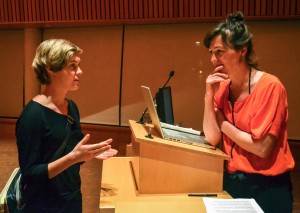Sara Hendren is an artist, researcher and writer. Her work focuses on adaptive technology, prosthetics and their application to the human body. She recently completed research in the Art, Design, and the Public Domain program at the Harvard Graduate School of Design. Her previous research included topics such as personal genomics and prosthetics for invisible conditions. She talked about her work on Wednesday night in JRC 101. Geo Gomez sat down with Hendren this week to talk sculpture, skateboards and Grinnell.
You spoke to one of our art classes on sculpture; what did you talk to them about?
I spoke to them about a specific project I’m working on. I have a project about a series of portable ramps. They’re designed for wheelchair users and skateboarders. I talked about the material language of wood, but also the way sculpture can function in a social way. The way that objects in public spaces can create conditions for social exchanges and performances that might not have been possible otherwise.
Most of the time in a public space around a building, you can identify an addition designated for a wheelchair user. What I’m trying to do with my design is mix the unlikely similar interest of skateboarders, who use ramps for play, and wheelchair users, who use ramps for access, to try and blur the line between who uses a ramp.
As in a lot of my work, I try to uncouple tools from their designated users and assigned diagnostics. I’m interested in how disability gets medicalized in a fairly rigid way and tools and technologies that are designed of those diagnoses have an overly literal and under-imagined material culture.

I’ve got to say I’ve never imagined wheelchair and skateboarders in the same category.
The project is online—it’s called Slope Intercept—at slopeintercept.org. By activating it with this design, I’m trying to engage both types of users, but also reinvigorate our historical imagination abut what this little piece of geometry does and what it’s done for the history of engineering and manufacturing. I’m mostly interested in big cities providing every level of infrastructure for all bodies to access all spaces, in the way that city planners and top-down government get hung up on mass policies and one-sided solutions.
One of the things that I feel really strongly about is the capacity of artists to work as amateurs who can create conditions that suggest alternate possibilities for large-scale projects for change. But they do it in an unsanctioned, unsolicited way. It’s practical because you create a spectacle—you get a journalist like yourself to cover that as spectacle, as culture, [and] suddenly you might raise an issue you want to have at the highest levels about polices and so on, without waiting through the proper channels and [hitting] the political constraints that tie up all good ideas.
It’s striking to think of a spectacle like that suddenly becoming a creative culture. Instead of adhering to something like a story that might focus on an incident with disability or a person it effects, it becomes something greater than just a disability.
The artists I’ve watched have said that I’m much more likely to get a political action covered as culture than any number of earnest “eat your spinach” kind of “here’s-something-you-should-care-abouts.” You’re more likely to get people interested if you use the modes of play, whimsy and enigma—if you create an enigma in public space that doesn’t explain itself readily. The mode in which I [engage people in conversation] is this playful intervention because we find that’s an opening for conversation, rather than a soapbox.
With the idea of prosthetics, how would you respond to the idea that prosthetics should be geared towards making a person feel “more human.”
I worry that some of the overwhelmingly dominant narrative around prosthetics is that they should only return bodies to what we think of as normal function. I do want prosthetics to do that. I also want prosthetics to be a site of imagination for digging down and drilling way deeper to become interrogative designs. Prosthetics can become cultural objects by which we do raise the questions of disability culture. We need to be very uncertain about how we assign people different conditions and what those conditions are like and where they follow them in terms of their normalcy, and then also what tools they want or need depending on their condition or otherwise.
What do you want Grinnell’s community to leave your lecture thinking differently about?
I would like for people to come away with an awareness of interrogative design, but a larger umbrella is critical design. At the level of products and objects and wearable things, we can object a much more questioning critical stance into the material language of the things we make. Sometimes the things we make can be much more powerful than our proclamations of language. The symbols and metaphors and multiple meanings and ambiguity we hear in critical objects are particularly powerful for occupying our imagination and altering our perceptions. I want critical design to be seen as doing political work.




























































